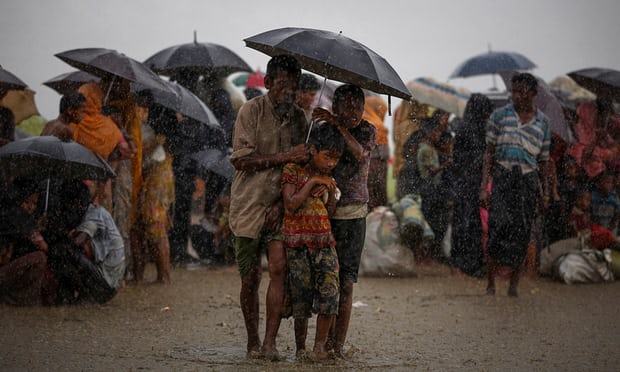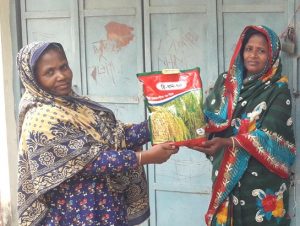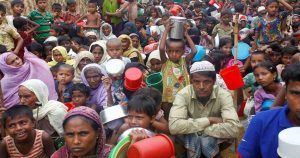or 14 terrifying days, Nabil Alam, his wife and nine children trudged through the jungles of northern Myanmar to reach the border with Bangladesh. The entire way, Alam looked over his shoulder for soldiers or local militia groups armed with clubs and knives.
That was eight months ago. Now, in the refugee camps of south-east Bangladesh, he is anxiously watching the sky, awaiting the dark clouds that will soon drench the area in months of monsoon rain.
Cox’s Bazar is one of the most frequently flooded regions of one of the most flood-prone countries on Earth. Bangladesh’s southern tip is fewer than three metres above sea level, with a triangular coast that funnels the ocean together. It makes high tides higher, and puts even major cities such as Chittagong within the water’s grasp.
As well as heightening the risk of floods, Bangladesh’s geography also makes for extraordinarily deadly storms. A cyclone in 1970 killed 300,000 people. Another in the same area in 1991 left an estimated 10 million people homeless. Cyclone Sidr, a decade ago, killed as many as 10,000 people.
Should cyclones bear down on the region again, as they have in the past two years, they could collide with nearly 700,000 new residents sleeping in tents of bamboo and tarpaulin. Aid agencies fear a second catastrophe is about to strike the Rohingya. “Lives will be lost,” says Daphnée Cook, Save the Children’s communications manager. “It’s just a question of how many.”
As many as 200,000 refugees are estimated to be at direct risk from landslides or floods and require urgent evacuation, separate assessments by the Bangladesh government and aid groups have concluded. Most have nowhere to go.
The first intense bursts of rainfall were recorded last week. As a test run for the monsoon, it has left aid agencies worried. Makeshift drains in parts of the vast camp quickly became blocked. Stretches of new dirt roads that serve as arteries for food and fuel turned to mud. The home of Sohina Khatum, 70, is already gone.
“It was raining in our area and my house was destroyed,” she says, waiting at a station where aid agencies are distributing bamboo stalks, tools and extra sheets of tarpaulin. “I lost everything I had. Even today I could not have any breakfast. I came straight here.”
Alam, 46, says his house has already flooded, spoiling the fortnightly supply of rice he receives as rations. “I had to take a loan from my neighbours to buy more,” he says.
Monsoons have battered Khatun’s village, Rasidong, in northern Myanmar, his entire life. When he was 18, he helped his father erect the family home on stilts but water would still get in. When he crossed the Naf river in September, contending with the rainy season had been the furthest thing from his mind.
“I didn’t even dare hope that we would cross the river, or find food and shelter,” he says. “It’s by the blessing of Allah that we even have a place to sleep and three meals.”
The sudden influx of so many new arrivals on the shores of Cox’s Bazar has fundamentally altered its geography. Rohingya settlements have so far chewed through 1,900 hectares of undeveloped forest given up by the Bangladesh government.
Root systems that once held the clay soil together, reducing landslides, have vanished. Major waterways are being dredged. Heavy machinery deployed by the government is levelling whole hillsides, heap by heap.
‘Only so much you can do with tarpaulin’
Bitter experience has taught Bangladesh how to manage cyclones and floods. The government has detailed procedures for warning the public and reducing the loss of life. But two responses are key: moving to higher ground and hunkering down in sturdy shelters. Neither are available to the Rohingya.
Cox’s Bazar is a safe haven from Burmese government persecution, but it is also an enormous detention centre. At least 27 military checkpoints around the camps restrict the refugees from leaving. Humanitarian agencies have moved at least 15,000 families living in the path of floods or landslides so far, but concede that there is not enough suitable land to relocate all those at risk.
Assisting the Rohingya to build strong homes is also out of the question. Bangladeshi public sentiment is starting to tire of the burden of more than a million displaced people, and it is an election year. Bricks roads and cement drains have been allowed, but not concrete homes. Like the presence of schools, they might suggest the refugees are in Cox’s Bazar to stay.
Instead, the Rohingya fortify their tents in any way they can, with sandbags, stronger rope and plastic bottles filled with dirt and hurled on the roofs of shelters.
“The devastation we were anticipating is likely to happen,” says Cook. “There’s only so much you can do with tarpaulin and bamboo. And only so much earth you can move to stop natural rivers from forming.”
Sitting on a mat inside his two-room shelter, Ramsol Hossain points out the corrugated iron roof he recently bought as fortification. “I used to prepare for the monsoon ever year, but this is totally different,” he says. “There aren’t enough materials. We’re trying to manage with what we have.”
As his children play outside, he mulls his dilemma. “If it floods, we would move to another part of the camp,” he says. “But we can’t do that without government permission.”
Once the rain arrives, some among a community that has been persecuted in Burma for generations could face a familiar choice. Stay and risk death, or run.




